
Page 42: of Offshore Engineer Magazine (Oct/Nov 2014)
Read this page in Pdf, Flash or Html5 edition of Oct/Nov 2014 Offshore Engineer Magazine
3D or additive printing has offshore applications,” But, she adds: “Flame retardant high performance caught the world’s imagination— thermoplastics, more cost-effective met- with the potential for human als and matching printer technologies
EPIC bone replacements and even bio- are being introduced by all of the major players, so we should see more activity ink being mooted. Elaine Maslin soon.” found out more.
Evolution
The technology has in fact been around since before the 1980s. It has taken a combination of advances in computing
The third (3D) and software and the release of a number of patents to help the technology reach its commercial potential. Much of the evolution of the technology has come industrial revolution?
from biomedical research (printing bones or other molecular, biological structures), n a relatively short space of time, 3D as well as circuits and electrode fabrica- printing has shot from being a quirky tion, according to a UK Government’s
I concept to a manufacturing method Intellectual Property Of? ce. available on the high street. It was the biological applications for
According to market insight ? rm 3D printing that ? rst caught the attention
Canalys, the size of the market, includ- of Professor Franek Hasiuk, a geol- ing 3D printer sales, materials and ogy professor at Iowa State University. associated services, reached US$2.5 Professor Hasiuk previously worked at a billion globally in 2013. Canalys pre- super major as a geochemist. He had been dicts that this will rise to $3.8 billion looking into core networks—the physical in 2014, with the market continuing to arrangement of reservoir rock structures experience rapid growth, reaching $16.2 that can hold oil and gas in place. When billion by 2018. he moved into academia he continued
Until recently, the scope of such tech- his research using computerized axial nologies for use in the upstream offshore tomography (CT), which led to reading
Maersk Oil’s digital core laboratory in Qatar. Photo from Maersk Oil.
oil industry has generally been viewed papers about CT in medical research, mechanical milling, spray forming, and 3D printing to manufacture jet engine as a tool for prototyping and modeling, and the potential to make bone implants other methods, and a direct metal laser fuel nozzles, which are normally made or simply as a fun piece of technology to using 3D printing. This in turn made melting machine. from a number of smaller parts welded have on your booth at industry events. Hasiuk think about the possibility to do
According to Monica Schnitger, from together, using cobalt chromium alloy But, the potential to print using minerals, the same for core samples, which could market intelligence ? rm Schnitger Corp., “dust,” created by turning molten alloys or metals, aided by advances in scanning then be used to perform experiments and there is not much additive manufacturing into powder through gas atomization, and computational technology, is open- test modelling. in the offshore sector yet. ing up more options. “It is dif? cult to get core samples “Most 3D printing today is still Maersk Tankers, a division of A.P. because they are hard obtain. But in making plastic parts, which making plastic parts, which Moller Maersk, has discussed having addition, each sample is different, het- don’t meet temperature onboard printers that are able to print erogeneous—even 1cm apart is different or pressure specs for off spare parts. GE is already using in a sample—so you cannot get a perfect
Scan this page!Scan this page!
Scan this entire page with your smartphone or tablet and the Actable app to see an interactive version of the 3D model at right.
At right: A large-scale 3D rock model created using CT scanning and modelling software.
Image from Professor Franek Hasiuk.
Far right: A selection of Maersk Oil 3D printed core samples.
Photo from Maersk Oil.
October 2014 | OE oedigital.com 44 044_OE1014_EPIC1_3D.indd 44 9/23/14 1:46 PM

 41
41

 43
43